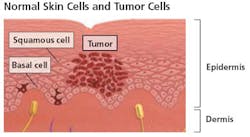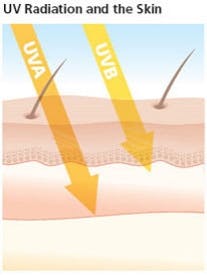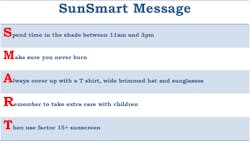The deadly mole, Don't Fry Day, personal melanoma stories
Regarding skin protection, not all sun creams offer the same protection against ultraviolet radiation from the sun. Ultraviolet radiation from the sun is divided into: UVA (Ultraviolet A - long-wave); UVB (Ultraviolet A – short wave); and UVC. UVC cannot get through the ozone layer to reach us so it isn't necessary for sun creams to protect against it. UVB radiation can cause sunburn and is linked to the development of skin cancer.
It was thought that UVA is fairly harmless to our skin; however, there is evidence that it can penetrate more deeply than UVB and may help cause cancer. Some sunscreens still don't have UVA protection. To help protect your skin from UVA, choose a sunscreen labeled broad spectrum. It is also important to choose a high factor sunscreen that will protect you from UVB. The Skin Cancer Foundation recommends the use of factor 15 or higher. (6) The Food and Drug Administration has regular updates on this and a variety of other topics.(7)
And last but not least, I want to thank the incredibly brave women who are sharing their personal stories with us this month. Laura and Shannon are long time friends, and Maria is my lovely niece. Luckily all the stories have happy endings.
Happy Summer … see you at the ADHA Meeting in Phoenix!
1. www.epa.gov/sunwise/. Accessed May 26, 2012. 2. www.epa.gov/enviro/mobile/. Accessed May 26, 2012. 3. epa.gov/sunwise/statefacts.html. Accessed May 26, 2012. 4. www.latimes.com/news/nation/nationnow/la-na-nn-nj-tanning-bed-mom-is-she-tanorexic-20120503,0,6219627.story. Accessed May 26, 2012. 5. The American Academy of Dermatology Association (AADA)Position Statement on Indoor Tanning. www.aad.org/Forms/Policies/Uploads/PS/PS-Indoor%20Tanning%2011-16-09.pdf. Accessed May 26, 2012. 6. www.skincancer.org/prevention/uva-and-uvb/understanding-uva-and-uvb. Accessed May 26, 2012. 7. FDA Consumer Updates www.fda.gov/ForConsumers/ConsumerUpdates/default.htm. Updated May 17, 2012. 8. cancerhelp.cancerresearchuk.org/about-cancer/cancer-questions/do-sun-creams-help-or-not. Accessed May 26, 2012. Sincerely,
Maria Perno Goldie, RDH, MS
To read previous RDH eVillage FOCUS introductions by Editorial Director Maria Perno Goldie, go to introductions.






